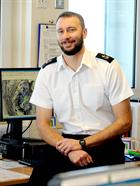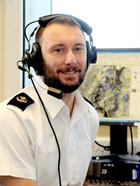ROYAL NAVAL RESERVIST HAS DOUBLE LOOK AT THE FORECAST
A Royal Naval Reservist from Barnstaple in Devon is helping shape the nation’s weather forecast in his day job as well as with the RNR Air Branch at Culdrose inWest Cornwall.
Leading Seaman James Bulpett, who in civilian life works for the Met Office atExeter, joined theUnited Kingdom's national weather service after serving six years in the Royal Navy where he was a Leading Airman in the Met Branch. During his naval service he helped the Fleet Air Arm’s weather forecasters at sea on some of the Royal Navy’s largest ships and on land at Royal Naval Air Station Culdrose. James’ role was to help predict the weather and produce forecasts for aviation and naval operations, gathering information and observing weather phenomena.
Working now at the Met Office HQ in Exeter, James’ job in the civilian environment has a direct crossover with his reservist role at Royal Naval Air Station Culdrose. On his days in uniform he carries out weather observations and inputs the information into the same collection system that he would normally monitor from his Exeteroffice. “My Reservist role with the Air Branch really complements my day job,” said James. “I get to collect the data at the air station and feed it up to the Met Office at Exeter where it’s then used in national forecasts. It’s pretty unique to be involved in both collecting and distributing this essential data for our UK forecasts.”
“I also have the benefit of bringing skills from two different workplaces into each of my roles, which is pretty useful both for me and them.”
Weather information from RNAS Culdrose is crucial to the Royal Navy’s aircraft and aircrew but is also one of 300 weather stations across the country that constantly feed into the Met Office and contributes to the national picture. Observations at the airfield, watching for weather fronts rolling in and analysing readings from the many instruments at site are all part of the Culdrose contribution made by James and his Met colleagues in the Royal Navy Reserve Air Branch.
James continues, “It’s very much hands on here at Culdrose, whereas what I do at Exeter is more in the background, making sure all that data is being captured and creating a more complete weather picture. I left the Navy to spend more time with my family and the Air Branch/Met Office combination certainly works for me - it’s a great contrast that suits.”




